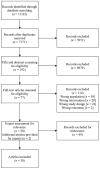Online Indicated Preventive Mental Health Interventions for Youth: A Scoping Review
- PMID: 33995136
- PMCID: PMC8116558
- DOI: 10.3389/fpsyt.2021.580843
Online Indicated Preventive Mental Health Interventions for Youth: A Scoping Review
Abstract
Objective: Between the ages of 12 and 25 the onset of mental disorders typically occurs, and the burden of mental health problems is greatest for this group. Indicated preventive interventions to target individuals with subclinical symptoms to prevent the transition to clinical levels of disorders have gained considerable traction. However, the threshold to seek help appears to be high even when help is needed. Online interventions could offer a solution, especially during the COVID-19 pandemic. This scoping review will present an overview of the recent research of indicated online preventive interventions for youth (12-25 years) experiencing the early stages of mental health complaints with the aim of identifying the nature and extent of the research evidence. Methods: The 5-stage framework by Arksey and O'Malley was used. Academic literature published from 2013 onwards in printed or electronic format was included from Scopus, PsychINFO, and Ovid MEDLINE(R) ALL. Results: The search yielded 11,122 results, with the final selection resulting in inclusion of 30 articles for this review. In total, the articles included 4,950 participants. 26.7% of the selected articles focused on youth between 12 and 25 years. Of the articles 60% did not screen for, nor exclude participants with clinical levels of symptoms. Most studies used a common evidence-based therapy for the disorder-category targeted. More than half of the online interventions included some form of human support. Adherence levels ranged between 27.9 and 98%. The results indicate general effectiveness, usability and acceptability of online indicated preventive interventions. The most commonly used approach was CBT (n = 12 studies). Studies varied in their size, rigor of study, effectiveness and outcome measures. Online interventions with a combination of clinical and peer moderation (n = 3 studies) appear to result in the most stable and highest effect sizes. Conclusion: Online indicated preventive mental health interventions for youth with emerging mental health issues show promise in reducing various mental health complaints, and increasing positive mental health indicators such as well-being and resilience. Additionally, high levels of usability and acceptability were found. However, the included studies show important methodological shortcomings. Also, the research has mainly focused on specific diagnostic categories, meaning there is a lack of transdiagnostic approaches. Finally, clear definitions of- as well as instruments to measure- emerging or subclinical mental health symptoms in youth remain are missing.
Keywords: digital; e-health; early detection and intervention; indicated prevention; mental health; scoping review; well-being; youth.
Copyright © 2021 van Doorn, Nijhuis, Egeler, Daams, Popma, van Amelsvoort, McEnery, Gleeson, Öry, Avis, Ruigt, Jaspers, Alvarez-Jimenez and Nieman.
Conflict of interest statement
The authors declare that the research was conducted in the absence of any commercial or financial relationships that could be construed as a potential conflict of interest.
References
-
- Organization WH . Promoting mental health: Concepts, emerging evidence, practice (Summary Report). Geneva: World Health Organization; (2004).
Publication types
LinkOut - more resources
Full Text Sources
Other Literature Sources


